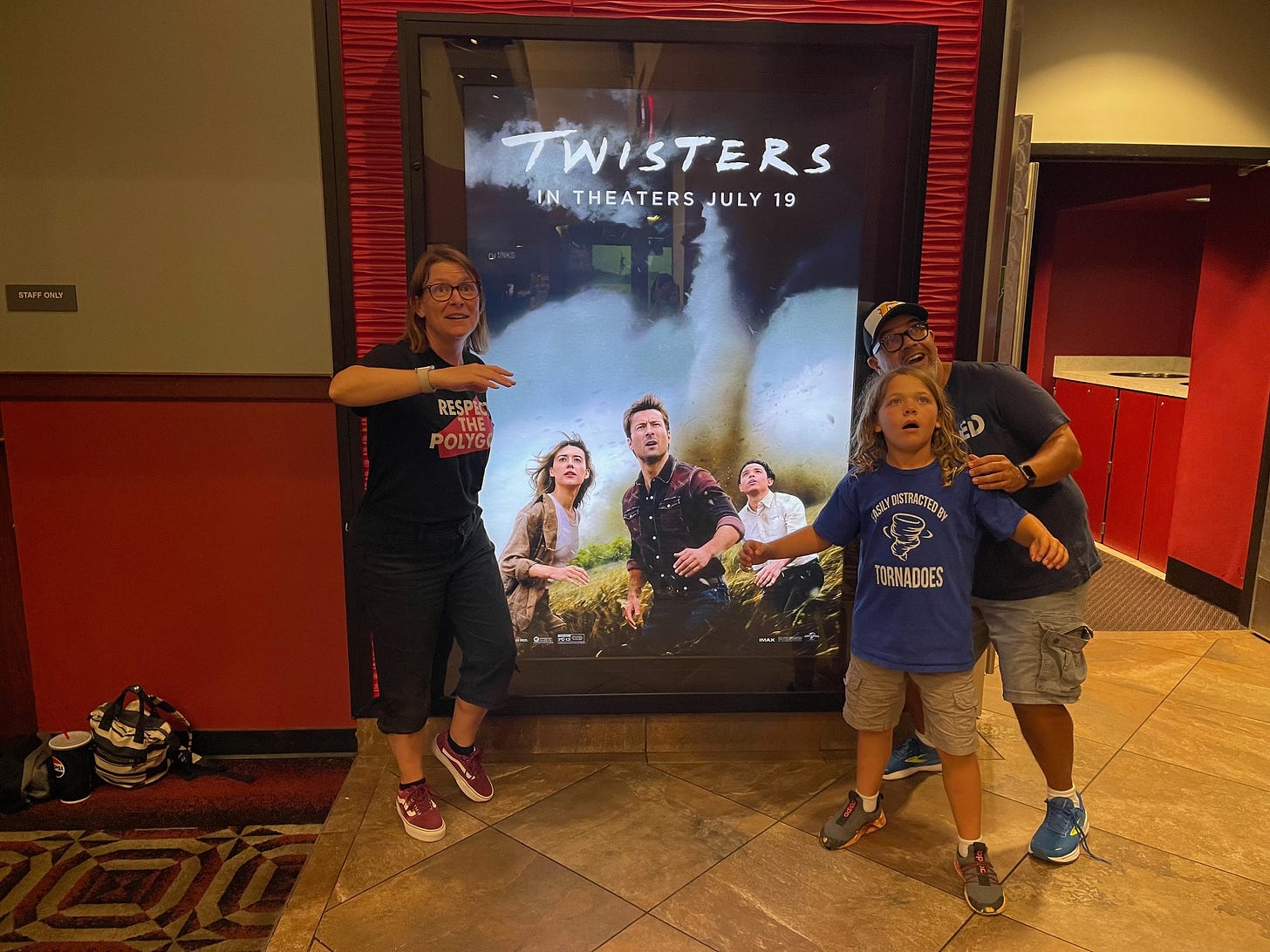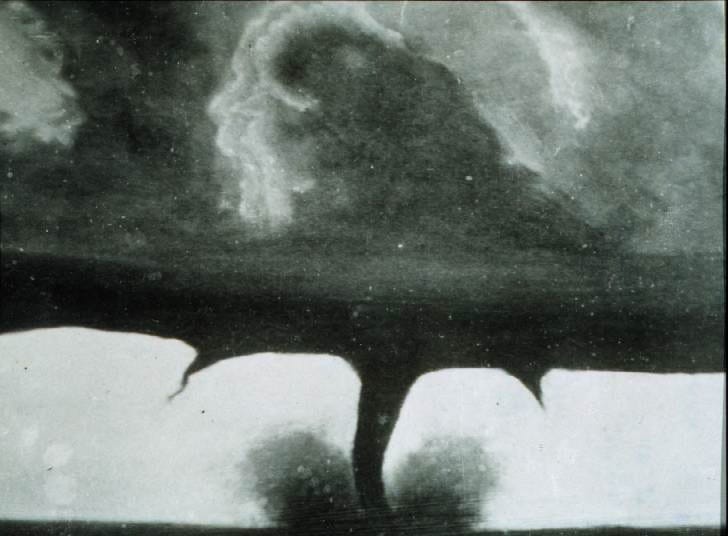Well, hello again! Seems that I took the summer off from writing to you all. Sorry about that! Sometimes the other parts of our lives, like a new job and a busy baseball season and a family vacation and starting school and finding our routines again, simply overwhelm us. Our favorite Mrs. Wilder coined the phrase “a whirl of gaiety,” and a more accurate description of our summer does not exist.
And it’s not for a lack of things to write about. So much has happened in the weather and climate world over the summer! A busy tornado season. Heat in the West and the East, including 100 consecutive days of 100 degrees or more in Phoenix. Wildfires, especially in the West. Milder and wetter weather in the Heartland. Corn sweat, even! (I’ll cover some of these topics in the coming weeks and months.)
Even though I’m a little late to the party, there is one topic especially on my mind: the movie “Twisters” (2024)! I saw the movie twice, once at the theater on release day with my family and once about a month later at a drive-in as a double feature with the original “Twister” (1996). I’m sure I’ll watch it a hundred more times, but for now, I feel like I have researched it carefully enough to have some Thoughts (capital T).
Is it a thumbs-up or thumbs-down recommendation from me? How accurate was the science? How does it compare to the original “Twister” (1996)? Keep reading! But before you do, I’m curious: Have you seen “Twisters” yet?
If you read on, there are some spoilers. Consider yourself… warned (pun intended!).

What “Twisters” Gets Right
1. The science is much better than the original “Twister” (1996). Weather weenie words like “Fujiwhara” and “phased array radar” (or “PAR”) are used in correct context. Storm behavior is described more accurately, including helpful descriptions of the ingredients that create storms. Even the motif of the main character looking at the waves of grain and grass to read the winds is not exactly wrong - exaggerated, maybe, in how she has a “vision” of it, but correct in the importance of the direction and speed of surface winds to forming tornadoes (a.k.a. “tornadogenesis”).
2. Call me a cynic, but I don’t need my strong female main characters to have a romance to make the story work. There is flirtation and intrigue, but the focus is on the storms and the things that humans do to try to save people from them. Hooray for that being enough.
3. There isn’t a “bad person” antagonist. Just about every character is flawed in some way, but nobody is painted as wholly evil, except maybe the one old businessman guy. The antagonists are the concept of preying on vulnerable people after a disaster, as well as the weather itself. People who could be stereotyped as bad, or at least ignorant and irresponsible, end up being intelligent and helpful. In fact, not judging a person by their persona is an important plot line.
4. The roles of scientists are much closer to reality than in the original “Twister” movie. In “Twister” (1996), the line “NSSL is predicting an F5” made scores of meteorologists cringe so hard that their necks shrunk. NSSL - the National Severe Storms Laboratory - is a research lab, not a prediction office. (The Storm Prediction Center, or SPC, is the prediction arm, along with the 122 National Weather Service Forecast Offices around the country.) NOAA makes an appearance in “Twisters” through a tour of an NWS office and implication of the main character’s job as a forecaster. There is some stretching of reality - you won’t see that many folks working at once in a forecast office unless it’s a high-impact weather day in the area, and forecasters generally don’t get to take lunch breaks out of the office - but those are minor quibbles. The director of “Twisters” consulted with NOAA and NWS meteorologists to improve the accuracy of how they show weather forecasting, and the improvement is clear and strong.
5. Some elements of chaser culture are faithfully represented in the movie. Clusters of chasers converge at gas stations in an area of chasing interest are common. Crowded hotels are common as the hordes of chasers look for a place to overnight (that’s great for the small-town economies!) , though I have yet to encounter a parking lot party as rambunctious as theirs. Some folks do make a living on the earnings of their social media as they live-stream their chasing experiences.
Oh, and that reference to a “$10 radar app”? Yes, I have it and recommend it. And yes, a whole bunch of people chase with that and a broad forecast, without real training in storm behavior and safety, and I felt that sentiment deeply about all the chasers there with their apps. A lot of those chasers also seek out more well-known chasers and simply follow them. I completely understand an interest in storms, but I’ll always recommend chasing with someone experienced before striking out solo.
6. Several times, characters refer to storms getting worse or increasing. Indeed, research has explored how storm patterns have been changing and will continue to change, and in most places, it’s a trend toward worse. Research is finding that the number of tornadoes on tornado days is increasing, that the frequency and/or number of tornadoes and severe storms is increasing in some parts of the country and in some seasons. It’s still a growing area of research, kind of a toddler in the research world, but we know enough to be concerned.
What “Twisters” Could Have Done Without
1. The main character and her group of college chasers say out loud that they shouldn’t take shelter under an overpass as a tornado approaches them (YAY!) … and then they do it anyway (NOOOOOOOOOOOOO!). They suffer the consequences, but I’d have rather not seen the myth of taking shelter under an overpass even mentioned, because too many people still do it and think that it’s safer when it is, in fact, more dangerous than open ground.
2. You can’t kill a tornado by seeding it so that it rains out. It is true that rain-cooled air can undercut a thunderstorm, and if it does, it can hinder a storm from producing a tornado. But it wouldn’t work to try to kill it from within - the energy balance is too strongly in favor of the tornado-producing thunderstorm.
3. It’s really not OK to drive into a community and tell the people who live there where to go for shelter if you don’t live there yourself. They certainly know much better than a stranger, someone who isn’t from that town. And by doing so, the chasers put themselves into harm’s way (and, by the way, directed people into an unsafe building).
4. It also isn’t a great idea to go drive into a town and start pulling people from the wreckage unless you are a trained rescue volunteer (e.g. paramedic or firefighter). Would-be rescuers can end up victims themselves, with dangers that include sharp debris (which can injure helpers and pop tires), downed live power lines, and gas leaks, among others. First responders need to spend their precious resources on those who live in the community and are victims, not interlopers, even if the interlopers have the best of intentions. Additionally, witnessing the aftermath can cause trauma and post-traumatic stress disorder, and it is more likely to happen in someone who is not trained to work in disaster zones. Better to stay out of harm’s way and help by donating money (NOT stuff - really) to communities impacted by a tornado.
And if one is indeed trained and inclined to offer first aid or help with search and rescue, I cannot say this strongly enough: TURN OFF YOUR CAMERAS. (A very famous storm chaser personality blocked me on social media because I scolded one of his dude-bro chaser buds for running his camera while approaching victims in wake of a tornado. People who just lost their homes and possibly are injured DO NOT want to be the stars of your YouTube channel or social media feed. It’s an incredible violation of privacy, takes advantage of vulnerable people after disaster, and screams of narcissism and self-importance of the person running their camera. I can’t believe this is even controversial to say, but in some circles, it is.)
5. People really don’t drive into tornadoes intentionally, especially whilst off-roading, and they sure don’t shoot fireworks and rockets into them. (Except for one certain very famous storm chaser personality with his special armored car and some of his imitators. But let’s not go there.) Let’s not make that a thing now, OK?
6. Traffic near chaseable storms is a nightmare most of the time, especially in Oklahoma. Traffic is nearly bumper to bumper on the good paved roads around a storm. Cars slow down and speed up without warning. Cars pull off to the side of the road - or fail to pull far enough to the side of the road before doors open and people climb out. It’s honestly one of the worst hazards of chasing. Many good chasers, caught in the traffic, have been cored by large hail and taken substantial damage to their cars because they could not get out of the storm’s path quickly enough.
And that’s just the list when folks have good intentions. Other poorly reputed chasers have intentionally blown stop signs, passed in no-passing zones, wildly exceeded speed limits when heading to a storm (one might argue that exceeding a speed limit to get away is less egregious), driven themselves off the road, and broken other traffic laws. Several of those have been caught on camera, and some even brazenly post their videos to their social media, while other dudebro chasers commend their close calls. (Don’t click on the videos. The last thing they deserve is clicks that reward their irresponsibility.)
None of this was captured well in the movie (other than the male main character driving around in open fields), and it could have added a realistic element of suspense and danger.
Overall Rating: Thumbs Up!
Despite the flaws I nitpicked, the movie is entertaining and the science is not bad. Go see it or rent it, especially if you liked the original “Twisters” (1996)! I’m here to answer all your questions about the movie, storm chasing, and tornadoes in the comments.
This Month in Wilder Weather History
August 28, 1884: A tornado outbreak brought several strong tornadoes to eastern Dakota Territory (South Dakota), including the one famously photographed (above). Laura Ingalls Wilder’s story in These Happy Golden Years about seeing a tornado while on a buggy ride with Almanzo occurred on this date, and the damage reports and injuries in her story are verified in other sources. At least 5 significant tornadoes (F2 or stronger) are known from this outbreak, along with seven known fatalities.




